Abdulaziz
Abdulaziz (Ottoman Turkish: عبد العزيز, romanized: Abdü'l Azīz Turkish: I. Abdülaziz; 8 February 1830 – 4 June 1876) was the 32nd Sultan of the Ottoman Empire and reigned between 25 June 1861 and 30 May 1876.[1] He was the son of Sultan Mahmud II and succeeded his brother Abdulmejid I in 1861.[3]
| Abdulaziz عبد العزيز | |||||
|---|---|---|---|---|---|
| Ottoman Caliph Amir al-Mu'minin Kayser-i Rûm Custodian of the Two Holy Mosques Khan | |||||
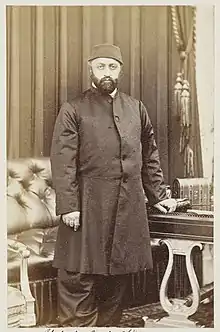 Sultan Abdulaziz during his visit to the United Kingdom in 1867. | |||||
| 32nd Sultan of the Ottoman Empire (Padishah) | |||||
| Reign | 25 June 1861 – 30 May 1876 | ||||
| Predecessor | Abdulmejid I | ||||
| Successor | Murad V | ||||
| Born | 8 February 1830 Constantinople, Ottoman Empire | ||||
| Died | 4 June 1876 (aged 46)[1] Feriye Palace, Constantinople, Ottoman Empire | ||||
| Burial | Tomb of Sultan Mahmud II, Fatih, Istanbul | ||||
| Consorts | |||||
| Issue | see below | ||||
| |||||
| Dynasty | Ottoman | ||||
| Father | Mahmud II | ||||
| Mother | Pertevniyal Sultan | ||||
| Religion | Sunni Islam | ||||
| Tughra |  | ||||
Born at Eyüp Palace, Constantinople (present-day Istanbul),[4][5] on 8 February 1830, Abdulaziz received an Ottoman education but was nevertheless an ardent admirer of the material progress that was made in the West. He was the first Ottoman Sultan who travelled to Western Europe, visiting a number of important European capitals including Paris, London and Vienna in the summer of 1867.
Apart from his passion for the Ottoman Navy, which had the world's third largest fleet in 1875 (after the British and French navies), the Sultan took an interest in documenting the Ottoman Empire. He was also interested in literature and was a talented classical music composer. Some of his compositions, together with those of the other members of the Ottoman dynasty, have been collected in the album European Music at the Ottoman Court by the London Academy of Ottoman Court Music.[6] He was deposed on grounds of mismanaging the Ottoman economy on 30 May 1876, and was found dead six days later under unnatural and mysterious circumstances.
Early life
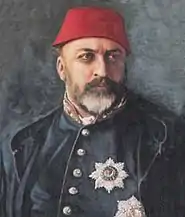
His parents were Mahmud II and Pertevniyal Sultan[7] (1812–1883), originally named Besime, a Circassian.[8] In 1868 Pertevniyal was residing at Dolmabahçe Palace. That year Abdulaziz took the visiting Eugénie de Montijo, Empress of France, to see his mother. Pertevniyal considered the presence of a foreign woman within her private quarters of the seraglio to be an insult. She reportedly slapped Eugénie across the face, which almost caused an international incident.[9] According to another account, Pertevniyal was outraged by the forwardness of Eugénie in taking the arm of one of her sons while he gave a tour of the palace garden, and she gave the Empress a slap on the stomach as a possibly more subtly intended reminder that they were not in France.[10]
The Pertevniyal Valide Sultan Mosque was built under the patronage of his mother. The construction work began in November 1869 and the mosque was finished in 1871.[11]
His paternal grandparents were Sultan Abdul Hamid I and Sultana Nakşidil Sultan. Several accounts identify his paternal grandmother with Aimée du Buc de Rivéry, a cousin of Empress Joséphine.[12] Pertevniyal was a sister of Khushiyar Qadin, third wife of Ibrahim Pasha of Egypt. Khushiyar and Ibrahim were the parents of Isma'il Pasha.[13][14]
Reign

Between 1861 and 1871, the Tanzimat reforms which began during the reign of his brother Abdulmejid I were continued under the leadership of his chief ministers, Mehmed Fuad Pasha and Mehmed Emin Âli Pasha. New administrative districts (vilayets) were set up in 1864 and a Council of State was established in 1868.[1] Public education was organized on the French model and Istanbul University was reorganised as a modern institution in 1861.[1] He was also integral in establishing the first Ottoman civil code.[1]

Abdulaziz cultivated good relations with France and the United Kingdom. In 1867 he was the first Ottoman sultan to visit Western Europe;[1] his trip included a visit to the Exposition Universelle (1867) in Paris and a trip to the United Kingdom, where he was made a Knight of the Garter by Queen Victoria[15] and shown a Royal Navy Fleet Review with Ismail Pasha. He travelled by a private rail car, which today can be found in the Rahmi M. Koç Museum in Istanbul. His fellow Knights of the Garter created in 1867 were Charles Gordon-Lennox, 6th Duke of Richmond, Charles Manners, 6th Duke of Rutland, Henry Somerset, 8th Duke of Beaufort, Prince Arthur, Duke of Connaught and Strathearn (a son of Queen Victoria), Franz Joseph I of Austria and Alexander II of Russia.
Also in 1867, Abdulaziz became the first Ottoman Sultan to formally recognize the title of Khedive (Viceroy) to be used by the Vali (Governor) of the Ottoman Eyalet of Egypt and Sudan (1517–1867), which thus became the autonomous Ottoman Khedivate of Egypt and Sudan (1867–1914). Muhammad Ali Pasha and his descendants had been the governors (Vali) of Ottoman Egypt and Sudan since 1805, but were willing to use the higher title of Khedive, which was unrecognized by the Ottoman government until 1867. In return, the first Khedive, Ismail Pasha, had agreed a year earlier (in 1866) to increase the annual tax revenues which Egypt and Sudan would provide for the Ottoman treasury.[16] Between 1854 and 1894,[16][17] the revenues from Egypt and Sudan were often declared as a surety by the Ottoman government for borrowing loans from British and French banks.[16][17] After the Ottoman government declared a sovereign default on its foreign debt repayments on 30 October 1875,[16] which triggered the Great Eastern Crisis in the empire's Balkan provinces that led to the devastating Russo-Turkish War (1877–78) and the establishment of the Ottoman Public Debt Administration in 1881,[16] the importance for Britain of the sureties regarding the Ottoman revenues from Egypt and Sudan increased.[17] Combined with the much more important Suez Canal which was opened in 1869, these sureties were influential in the British government's decision to occupy Egypt and Sudan in 1882, with the pretext of helping the Ottoman-Egyptian government to put down the ʻUrabi revolt (1879–1882). Egypt and Sudan (together with Cyprus) nominally remained Ottoman territories until 5 November 1914,[18] when the British Empire declared war against the Ottoman Empire during World War I.[18]
In 1869, Abdulaziz received visits from Eugénie de Montijo, Empress consort of Napoleon III of France and other foreign monarchs on their way to the opening of the Suez Canal. The Prince of Wales, the future Edward VII, twice visited Istanbul.[15]
By 1871 both Mehmed Fuad Pasha and Mehmed Emin Âli Pasha were dead.[1] The Second French Empire, his Western European model, had been defeated in the Franco-Prussian War by the North German Confederation under the leadership of the Kingdom of Prussia. Abdulaziz turned to the Russian Empire for friendship, as unrest in the Balkan provinces continued. In 1875, the Herzegovinian rebellion was the beginning of further unrest in the Balkan provinces. In 1876, the April Uprising saw insurrection spreading among the Bulgarians. Ill feeling mounted against Russia for its encouragement of the rebellions.[1]
While no one event led to his being deposed, the crop failure of 1873 and his lavish expenditures on the Ottoman Navy and on new palaces which he had built, along with mounting public debt, helped to create an atmosphere conducive to his being overthrown. Abdulaziz was deposed by his ministers on 30 May 1876.[1]
Death
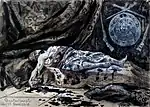
Abdulaziz's death at Çırağan Palace in Istanbul a few days later was documented as a suicide.[1][19]
Following Sultan Abdulaziz's dethronement, he was taken into a room at Topkapi Palace. This room happened to be the same room that Sultan Selim III was murdered in. The room caused him to be concerned for his life and he subsequently requested to be moved to Beylerbeyi Palace. His request was denied for the palace was considered inconvenient for his situation and he was moved to Feriye Palace instead. He nevertheless had grown increasingly nervous and paranoid about his security. In the morning of 5 June, Abdulaziz asked for a pair of scissors to trim his beard. Shortly after this, he was found dead in a pool of blood flowing from two wounds in his arms.
Several physicians were allowed to examine his body. Among which "Dr. Marco, Nouri, A. Sotto, Physician attached to the Imperial and Royal Embassy of Austria‐Hungary; Dr. Spagnolo, Marc Markel, Jatropoulo, Abdinour, Servet, J. de Castro, A. Marroin, Julius Millingen, C. Caratheodori; E. D. Dickson, Physician of the British Embassy; Dr. O. Vitalis, Physician of the Sanitary Board; Dr. E. Spadare, J. Nouridjian, Miltiadi Bey, Mustafa, Mehmed" certified that the death had been "caused by the loss of blood produced by the wounds of the blood‐vessels at the joints of the arms" and that "the direction and nature of the wounds, together with the instrument which is said to have produced them, lead us to conclude that suicide had been committed".[20] One of those physicians also stated that "His skin was very pale, and entirely free from bruises, marks or spots of any kind whatever. There was no lividity of the lips indicating suffocation nor any sign of pressure having been applied to the throat".[21]
There are several sources claiming the death of Abdulaziz was due to an assassination by those who dethroned him.
Necip Fazıl Kısakürek was the first author to claim the death of Abdualziz was an assassination. Kısakürek claimed that it was a clandestine operation carried out by the British government and its proxies with an anti-Islamic motivation, opining that "the English being the greatest enemy of Islam" was the motivation behind their supposed assassination.[22]

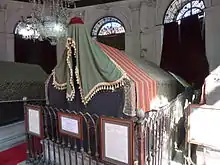
Another similar claim is based on the book of Memoirs by Sultan Abdulhamid II. In the book, Abdulhamid claims that Sultan Murad V had begun to show signs of paranoia, madness, and continuous fainting and vomiting until the day of his coronation, and he even threw himself into a pool yelling at his guards to protect his life. High ranked politicians of the time were afraid the public would become outraged and revolt to bring back Abdulaziz to the power. Thus, they arranged the assassination of Abdulaziz by cutting his wrists and announced that he committed suicide".[23] This book of memoir is commonly referred to as a first hand testimony of the assassination of Abdulaziz. Yet it's proven, later on, that Abdulhamid II never wrote nor dictated such a document. The book turned out to be merely a fraud.[24][25]
A photograph[26] published in the book Hatıra-i Uhuvvet: Portre Fotoğraflarının Cazibesi 1846-1950 by Bahattin Öztuncay has also had a considerable attention of the assassination theorists. In the photograph, Abdulaziz, presumably after being overthrown, is seen sitting in front of the camera. On his both sides, two men are standing and one of which is seen with an alleged Masonic hidden hand gesture. Even though there's nothing asserts any violence in the photograph, it's presented as the proof of the assassination, possibly because leaning on former sultan's chair is considered disrespectful.
Achievements
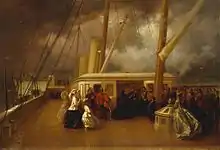
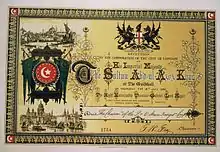

- Abdulaziz gave special emphasis on modernizing the Ottoman Navy. In 1875, the Ottoman Navy had 21 battleships and 173 warships of other types, ranking as the third largest navy in the world after the British and French navies. His passion for the Navy, ships and sea can be observed in the wall paintings and pictures of the Beylerbeyi Palace on the Bosphorus strait in Istanbul, which was constructed during his reign. However, the large budget for modernizing and expanding the Navy (combined with a severe drought in 1873 and incidents of flooding in 1874 which damaged Ottoman agriculture and reduced the government's tax revenues) contributed to the financial difficulties which caused the Porte to declare a sovereign default with the "Ramazan Kanunnamesi" on 30 October 1875. The subsequent decision to increase agricultural taxes for paying the Ottoman public debt to foreign creditors (mainly British and French banks) triggered the Great Eastern Crisis in the empire's Balkan provinces, which culminated in the Russo-Turkish War (1877–78) that devastated the already struggling Ottoman economy, and the establishment of the Ottoman Public Debt Administration in 1881, during the early years of Sultan Abdülhamid II's reign.
- The first Ottoman railroads were opened between İzmir–Aydın and Alexandria–Cairo in 1856, during the reign of Sultan Abdulmejid I. The first large railway terminal within present-day Turkey, the Alsancak Terminal in Izmir, was opened in 1858. However, these were individual, unconnected railroads, without a railway network. Sultan Abdulaziz established the first Ottoman railway networks. On 17 April 1869, the concession for the Rumelia Railway (i.e. Balkan Railways, Rumeli (Rumelia) meaning the Balkan peninsula in Ottoman Turkish) which connected Istanbul to Vienna was awarded to Baron Maurice de Hirsch (Moritz Freiherr Hirsch auf Gereuth), a Bavaria-born banker from Belgium. The project foresaw a railway route from Istanbul via Edirne, Plovdiv and Sarajevo to the shore of the Sava River. In 1873, the first Sirkeci Terminal in Istanbul was opened. The temporary Sirkeci terminal building was later replaced with the current one which was built between 1888 and 1890 (during the reign of Abdülhamid II) and became the final destination terminus of the Orient Express. In 1871, Sultan Abdulaziz established the Anatolia Railway. Construction works of the 1,435 mm (4 ft 8 1⁄2 in) standard gauge on the Asian side of Istanbul, from Haydarpaşa to Pendik, began in 1871. The line was opened on 22 September 1872.[27] The railway was extended to Gebze, which opened on 1 January 1873. In August 1873 the railway reached Izmit. Another railway extension was built in 1871 to serve a populated area along Bursa and the Sea of Marmara. The Anatolia Railway was then extended to Ankara and eventually to Mesopotamia, Syria and Arabia during the reign of Sultan Abdülhamid II, with the completion of the Baghdad Railway and Hejaz Railway.
- Under his reign, Turkey's first postage stamps were issued in 1863, and the Ottoman Empire joined the Universal Postal Union in 1875 as a founding member.
- He also was responsible for the first civil code for the Ottoman Empire.[1]
- He was the first Ottoman sultan who travelled to Western Europe. His voyage in visiting order (from 21 June 1867 to 7 August 1867): Istanbul – Messina – Naples – Toulon – Marseille – Paris – Boulogne – Dover – London – Dover – Calais – Brussels – Koblenz – Vienna – Budapest – Orșova – Vidin – Ruse – Varna – Istanbul.[28]
- Impressed by the museums in Paris (30 June – 10 July 1867),[28] London (12–23 July 1867)[28] and Vienna (28–30 July 1867)[28] which he visited in the summer of 1867, he ordered the establishment of an Imperial Museum in Istanbul: the Istanbul Archaeology Museum.
- He was made the 756th Knight of the Order of the Garter in 1867[29] and the 127th Grand Cross of the Order of the Tower and Sword.
Personal life
Abdulaziz had five wives. They were Dürrünev Kadın, Hayranidil Kadın, Edadil Kadın, Nesrin Kadın, and Gevheri Kadın.[30][a] He also wanted to marry Princess Tawhida Hanim, daughter of Isma'il Pasha, khedive of Egypt. However, grand vizier Mehmed Fuad Pasha opposed the love match on the grounds that Isma'il then would have too favourable a backstairs entrée to the Sultan.[31] Fuad's objection was written on a small paper, and given to the head chamberlain, who instead of reading it to Abdulaziz, handed it to him. The Sultan was insulted, Fuad was fired, and the marriage plans were cancelled.[31]
- Issue
| Name | Birth | Death | Notes |
|---|---|---|---|
| By Dürrünev Kadın (married 20 May 1856; 15 March 1835 – 7 December 1895) | |||
| Şehzade Yusuf Izzeddin | 11 October 1857[32][33][34] | 1 February 1916[33][34] | married six times, and had issue, two sons and two daughters |
| Saliha Sultan | 11 July 1862[35][36][37] | 1941[36][37] | married once, and had issue, one daughter |
| Şehzade Mehmed Selim | 28 September 1866[32] | 23 October 1867[32] | born and died in infancy in Dolmabahçe Palace; buried in tomb of Mahmud II |
| By Hayranidil Kadın (married 1861; 2 November 1846 – 26 November 1895) | |||
| Nazime Sultan | 14 February[35] 1867[38][39] | 1947[39] | married once without issue |
| Abdulmejid II | 29 May 1868[40][41][42] | 23 August 1944[41][42] | married four times, and had issue, one son and one daughter |
| By Edadil Kadın (married 1861; c. 1845 – 12 December 1875) | |||
| Şehzade Mahmud Celaleddin | 14 November 1862[32][41][43] | 1 September 1888[41][43] | married once without issue |
| Emine Sultan | 1 December 1866[35][38] | 24 February 1867[35][38] | born and died in infancy in Dolmabahçe Palace; buried in tomb of Mahmud II |
| By Nesrin Kadın (married 1868; c. 1848 – 11 June 1876) | |||
| Şehzade Mehmed Şevket | 10 June 1869[32][41] | 22 October 1899 | married once, and had issue, one son |
| Emine Sultan | 24 August 1874[32][44][45] | 29 January 1920[44][45] | married once, and had issue, one daughter |
| By Gevheri Kadın (married 1872; 8 July 1856 – 6 September 1884) | |||
| Esma Sultan | 21 March 1873[46][47][48] | 7 May 1899[47][48] | married once, and had issue, three sons and one daughter |
| Şehzade Mehmed Seyfeddin | 21 September 1874[32][41] | 19 October 1927 | married twice, and had issue, three sons and one daughter |
Annotations
References
- Hoiberg, Dale H., ed. (2010). "Abdülaziz". Encyclopædia Britannica. I: A-ak Bayes (15th ed.). Chicago, IL: Encyclopædia Britannica Inc. pp. 21. ISBN 978-1-59339-837-8.
- Garo Kürkman, (1996), Ottoman Silver Marks, p. 46
- Chambers Biographical Dictionary, ISBN 0-550-18022-2, page 2
- Britannica, Istanbul: When the Republic of Turkey was founded in 1923, the capital was moved to Ankara, and Constantinople was officially renamed Istanbul in 1930.
- Finkel, Caroline, Osman's Dream, (Basic Books, 2005), 57; "Istanbul was only adopted as the city's official name in 1930..".
- European Music at the Ottoman Court, London Academy of Ottoman Court Music. CD album released on 6 November 2000. ASIN: B0000542KD.
- Daniel T. Rogers, "All my relatives: Valide Sultana Partav-Nihal"
- His profile in the Ottoman Web Site
- "Women in Power" 1840-1870, entry: "1861-76 Pertevniyal Valide Sultan of The Ottoman Empire"
- Duff, David (1978). Eugenie and Napoleon III. New York: William Morrow. p. 191. ISBN 0688033385.
- "Pertevniyal Valide Sultan Mosque Complex". Discover Islamic Art. Retrieved 26 January 2008.
- Christine Isom-Verhaaren, "Royal French Women in the Ottoman Sultans' Harem: The Political Uses of Fabricated Accounts from the Sixteenth to the Twenty-first Century" Archived 25 October 2006 at the Wayback Machine
- "Non European Royalty Website, entry:"Egypt"". Archived from the original on 16 July 2017. Retrieved 6 August 2015.
- "Women in Power" 1840-1870, entry: "1863-79 Valida Pasha Khushiyar of Egypt"
- Chisholm, Hugh, ed. (1911). "Abd-ul-Aziz". Encyclopædia Britannica. 1 (11th ed.). Cambridge University Press. p. 35.
- Mevzuat Dergisi, Yıl: 9, Sayı: 100, Nisan 2006: "Osmanlı İmparatorluğu'nda ve Türkiye Cumhuriyeti'nde Borçlanma Politikaları ve Sonuçları"
- Article 18 of the Treaty of Lausanne (1923)
- Articles 17, 18, 19, 20 and 21 of the Treaty of Lausanne (1923)
- Davis, Claire (1970). The Palace of Topkapi in Istanbul. New York: Charles Scribner's Sons. pp. 222. ASIN B000NP64Z2.
- Ali Haydar Midhat Bey (1903). The Life of Midhat Pasha. London: JOHN MURRAY. pp. 89–90.
- Dickson, E. D. (8 July 1876). "Report on the Death of the Ex-Sultan Abdul Aziz Khan". The British Medical Journal. 2 (810): 41–12. doi:10.1136/bmj.2.810.41. PMC 2297901. PMID 20748260.
- Kısakürek, Necip Fazıl (2007). Ulu Hakan: II. Abdülhamid Han. İstanbul: Büyük Doğu Yayınları. p. 688. ISBN 9789758180301.
- Bozdağ, İsmet (2000). Sultan Abdülhamid'in Hatıra Defteri. İstanbul: Pınar Yayınları. p. 223. ISBN 9753520344.
- Murat Bardakçı, Abdülhamid’in hatıra defteri yoktur, bu isimdeki kitap sahtedir, inanmayın ve kullanmayın! (Turkish)
- Prof. Dr. Ali Birinci, Sultan Abdülhamid'in Hatıra Defteri Meselesi (Turkish)
- Abdulaziz's photograph along with two men
- CFOA History - Trains and Railways of Turkey
- Voyage of Sultan Abdülaziz to Europe (21 June 1867 – 7 August 1867)
- Wm. A. Shaw, The Knights of England, Volume I (London, 1906) page 64
- Karahüseyin, Güller; Saçaklı, Palin Aykut (2004). Dolmabahçe Sarayı Harem Dairelerinin Mekan Fonksiyonlart Açısından Değerlendirilmesi. TBMM Milli Saraylar Daire Başkanlığı Yayını Istanbul. pp. 86, 101.
- Davidson, Roderic H. (8 December 2015). Reform in the Ottoman Empire, 1856-1876. Princeton University Press. pp. 200 n. 102. ISBN 978-1-400-87876-5.
- Uçan 2019, p. 24.
- Uluçay 2011, p. 232.
- Brookes 2010, p. 291.
- Uçan 2019, p. 23.
- Uluçay 2011, p. 234.
- Brookes 2010, p. 289.
- Uluçay 2011, p. 235.
- Brookes 2010, p. 286.
- Uçan 2019, p. 15.
- Uluçay 2011, p. 233.
- Brookes 2010, p. 278.
- Brookes 2010, p. 283.
- Uluçay 2011, p. 236.
- Brookes 2010, p. 280.
- Uçan 2019, p. 23-24.
- Uluçay 2011, p. 235-36.
- Brookes 2010, p. 281.
- Uçan 2019, pp. 21, 23.
- Tunç, Muhammed Nuri (2013). Ceyb-i Hümâyûn Hazinesi ve Topkapı Sarayı Müzesi Arşivi R.1288 (M.1872) Tarihli Ceyb ve Harc-ı Jâssa Defterlerinin Transkripsiyonu ve Değerlendirilmesi (PhD Thesis). Gaziantep University Institute of Social Sciences. p. 113.
Sources
- Brookes, Douglas Scott (2010). The Concubine, the Princess, and the Teacher: Voices from the Ottoman Harem. University of Texas Press. ISBN 978-0-292-78335-5.
- Uçan, Lâle (2019). Son Halife Abdülmecid Efendi'nin Hayatı - Şehzâlik, Veliahtlık ve Halifelik Yılları (PDF) (PhD Thesis). Istanbul University Institute of Social Sciences.
- Uluçay, M. Çağatay (2011). Padişahların kadınları ve kızları. Ötüken. ISBN 978-9-754-37840-5.
External links
![]() Media related to Abdül Aziz I at Wikimedia Commons
Media related to Abdül Aziz I at Wikimedia Commons
![]() Works written by or about Abdülaziz at Wikisource
Works written by or about Abdülaziz at Wikisource
- . Collier's New Encyclopedia. 1921.
Abdulaziz Born: 8 February 1830 Died: 4 June 1876 | ||
| Regnal titles | ||
|---|---|---|
| Preceded by Abdulmejid I |
Sultan of the Ottoman Empire 25 June 1861 – 30 May 1876 |
Succeeded by Murad V |
| Sunni Islam titles | ||
| Preceded by Abdulmejid I |
Caliph of the Ottoman Caliphate 25 June 1861 – 30 May 1876 |
Succeeded by Murad V |

.svg.png.webp)